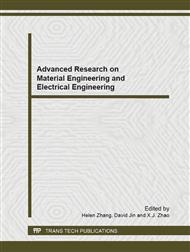p.3
p.8
p.13
p.17
p.22
p.27
p.31
p.35
Research on Electron Mobility Model for Tensile Strained-Si(101) with Properties of Semiconducting Materials
Abstract:
Abstract. Mobility is one of the most important properties of semiconductor material, and it has a great impact on the property of MOS devices.In this paper, the influence of ionizing impurity scattering, acoustic phonon scattering and intervalley scattering to strained-Si(101) material is discussed.In addition, a calculation of the electron mobility in Strained-Si(101) material is made using the average momentum relaxation time method described in Ref[1]. The results show that the electron mobility increases gradually for both [001] and [100] orientations while for [010] orientation increases rapidly with the increasing Ge fraction x.
Info:
Periodical:
Pages:
8-12
Citation:
Online since:
March 2013
Authors:
Keywords:
Price:
Сopyright:
© 2013 Trans Tech Publications Ltd. All Rights Reserved
Share:
Citation:


